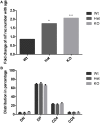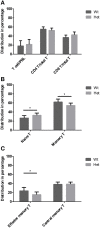PPARgamma Deficiency Counteracts Thymic Senescence
- PMID: 29163553
- PMCID: PMC5681731
- DOI: 10.3389/fimmu.2017.01515
PPARgamma Deficiency Counteracts Thymic Senescence
Abstract
Thymic senescence contributes to increased incidence of infection, cancer and autoimmunity at senior ages. This process manifests as adipose involution. As with other adipose tissues, thymic adipose involution is also controlled by PPARgamma. This is supported by observations reporting that systemic PPARgamma activation accelerates thymic adipose involution. Therefore, we hypothesized that decreased PPARgamma activity could prevent thymic adipose involution, although it may trigger metabolic adverse effects. We have confirmed that both human and murine thymic sections show marked staining for PPARgamma at senior ages. We have also tested the thymic lobes of PPARgamma haplo-insufficient and null mice. Supporting our working hypothesis both adult PPARgamma haplo-insufficient and null mice show delayed thymic senescence by thymus histology, thymocyte mouse T-cell recombination excision circle qPCR and peripheral blood naive T-cell ratio by flow-cytometry. Delayed senescence showed dose-response with respect to PPARgamma deficiency. Functional immune parameters were also evaluated at senior ages in PPARgamma haplo-insufficient mice (null mice do not reach senior ages due to metabolic adverse affects). As expected, sustained and elevated T-cell production conferred oral tolerance and enhanced vaccination efficiency in senior PPARgamma haplo-insufficient, but not in senior wild-type littermates according to ELISA IgG measurements. Of note, humans also show increased oral intolerance issues and decreased protection by vaccines at senior ages. Moreover, PPARgamma haplo-insufficiency also exists in human known as a rare disease (FPLD3) causing metabolic adverse effects, similar to the mouse. When compared to age- and metabolic disorder-matched other patient samples (FPLD2 not affecting PPARgamma activity), FPLD3 patients showed increased human Trec (hTrec) values by qPCR (within healthy human range) suggesting delayed thymic senescence, in accordance with mouse results and supporting our working hypothesis. In summary, our experiments prove that systemic decrease of PPARgamma activity prevents thymic senescence, albeit with metabolic drawbacks. However, thymic tissue-specific PPARgamma antagonism would likely solve the issue.
Keywords: PPARgamma; immunity; rejuvenation; senescence; thymus.
Figures






Similar articles
-
Transgenic Exosomes for Thymus Regeneration.Front Immunol. 2019 Apr 24;10:862. doi: 10.3389/fimmu.2019.00862. eCollection 2019. Front Immunol. 2019. PMID: 31110503 Free PMC article.
-
Wnt4 and LAP2alpha as pacemakers of thymic epithelial senescence.PLoS One. 2010 May 18;5(5):e10701. doi: 10.1371/journal.pone.0010701. PLoS One. 2010. PMID: 20502698 Free PMC article.
-
"Beige" Cross Talk Between the Immune System and Metabolism.Front Endocrinol (Lausanne). 2019 Jun 18;10:369. doi: 10.3389/fendo.2019.00369. eCollection 2019. Front Endocrinol (Lausanne). 2019. PMID: 31275241 Free PMC article.
-
Implications of Oxidative Stress and Cellular Senescence in Age-Related Thymus Involution.Oxid Med Cell Longev. 2020 Feb 5;2020:7986071. doi: 10.1155/2020/7986071. eCollection 2020. Oxid Med Cell Longev. 2020. PMID: 32089780 Free PMC article. Review.
-
Thymic function in HIV-infection.Dan Med J. 2013 Apr;60(4):B4622. Dan Med J. 2013. PMID: 23651726 Review.
Cited by
-
Transgenic Exosomes for Thymus Regeneration.Front Immunol. 2019 Apr 24;10:862. doi: 10.3389/fimmu.2019.00862. eCollection 2019. Front Immunol. 2019. PMID: 31110503 Free PMC article.
-
Transcriptome analysis reveals the alleviating effect of Polysaccharide of Atractylodes macrocephala Koidz on thymic involution in Magang geese.Poult Sci. 2025 Jun;104(6):105155. doi: 10.1016/j.psj.2025.105155. Epub 2025 Apr 12. Poult Sci. 2025. PMID: 40245540 Free PMC article.
-
Thymic involution caused by repeated cocaine administration includes apoptotic cell loss followed by ectopic adipogenesis.PLoS One. 2022 Nov 28;17(11):e0277032. doi: 10.1371/journal.pone.0277032. eCollection 2022. PLoS One. 2022. PMID: 36441681 Free PMC article.
-
Circadian alignment of early onset caloric restriction promotes longevity in male C57BL/6J mice.Science. 2022 Jun 10;376(6598):1192-1202. doi: 10.1126/science.abk0297. Epub 2022 May 5. Science. 2022. PMID: 35511946 Free PMC article.
-
Notch1 Inhibits Rosiglitazone-Induced Adipogenic Differentiation in Primary Thymic Stromal Cells.Front Pharmacol. 2018 Nov 12;9:1284. doi: 10.3389/fphar.2018.01284. eCollection 2018. Front Pharmacol. 2018. PMID: 30483127 Free PMC article.
References
LinkOut - more resources
Full Text Sources
Other Literature Sources
Research Materials

